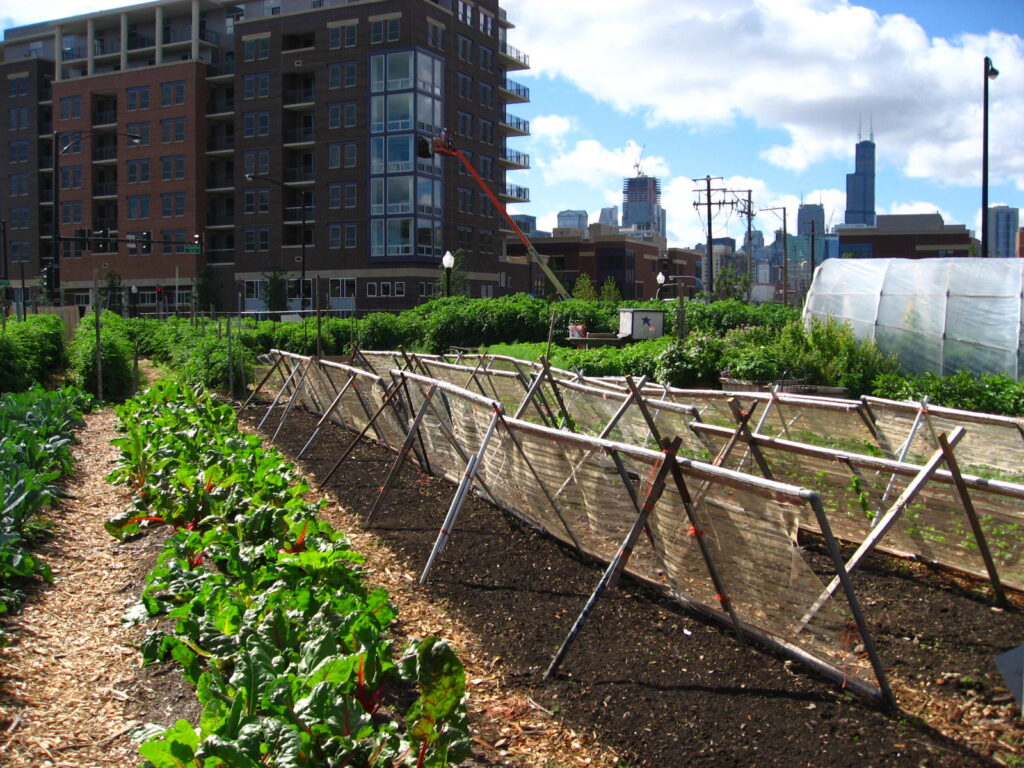Green Gentrification: Do Gardens Drive Displacement?
Atticus Lee | February 21, 2023

Our built environment is on the cusp of a green future fueled by President Biden’s recent S.874 – BUILD GREEN Infrastructure and Jobs Act 2022. This bill and other initiatives by states and local governments have the potential to catalyze the transformation of urban settings into resilient green communities. As these policies are enacted, cities across the United States are preparing to implement urban greening projects such as expanding park infrastructure and building up community gardens and farms; but one must question whether these projects contribute to the concurrent crisis of gentrification and rising housing costs in urban America.
Gentrification is complex process, commonly defined as “the process of improving an area of a town or city so that it attracts people of a higher social class than before”. Green gentrification is a specific variant, which describes how the development or enhancement of parks and other forms of green space contribute to the improvement of an area and the attraction of outsiders.
Notably, urban greening projects provide access to healthy lifestyle habits in various forms, including physical activity, mental healthcare, and healthy eating. In terms of access to healthy food, urban agriculture has the potential to provide local food options in food deserts, reduce food costs, encourage community engagement and healthy lifestyles. In urban centers nationwide, the prevalence of food deserts remains highest in low-income neighborhoods. While urban agriculture aims to address this issue by repairing holes in the broken system, it runs the risk of creating further tears in a community’s culture if it is part of a green gentrification process.
Recent research from the Urban Sustainability Group at the University of Michigan challenges the notion of urban agriculture leading to gentrification. In their study of Detroit, Michigan, researchers found that urban agriculture did not trigger green gentrification that led to displacement of residents, and urban farms tended to be located in local food deserts. However, they did find that young, affluent, white residents were more likely to have gardens than the rest of the city’s predominantly Black population. This is consistent with previous research by Julie Guthman, who found that African American communities were often resistant or slow to embrace alternative food system practices being advocated by comparatively affluent white students.
The surprising lack of evidence of green gentrification in the University of Michigan study could be due to their definition of gentrification: the “well-documented process by which low-income communities are physically and culturally displaced by middle- and high-income populations, typically through increased real estate value” (P. 1). This definition deliberately identifies the acts of physical and cultural displacement as key components of gentrification, whereas the more common definition does not directly refer to displacement as an indicator of gentrification, and instead emphasizes the process of improvements leading to a more attractive city for affluent residents.

Legacy Cities vs. Growth Cities
Detroit is a city that has experienced 70 years of declining population, as well as a history of racism and economic decline that has led to mass exodus of white residents relocating to the suburbs. These are the characteristics of a legacy city, with a harsh postindustrial environment, common among cities in the Rust Belt of the United States. While much of the city’s population struggles with housing burden, vacancy rates remain higher than in many cities, with one in every five housing units unoccupied. As a result, many neighborhoods do not face the same pressures for space that other rapidly-growing communities experience. In part, this may explain the lack of displacement resulting from urban agriculture investment found in this study and complicate the transferability of these findings to other urban areas.
This city-wide trauma has led to ample opportunities to implement expansive urban agriculture projects, as vacant properties flooded the real estate markets in the 2000s to early 2010s. Within this context of recovering from disinvestment and the relative surplus of available land, the study’s findings that Detroit’s influx of urban gardens did not act as a driver of displacement, differs from findings in growth cities that face tight housing markets like Washington D.C. and Los Angeles, California.
In considering the causal effect of urban agriculture on displacement, it is important to consider the types of gardens analyzed in the Detroit study. The researchers included 478 home gardens and 130 community gardens in their analysis. While community gardens may represent a public amenity that influences market value of a neighborhood, home gardens are more likely to be installed by residents after moving into a space. As such they may serve more as an indicator of gentrification in a community, which is driven by other improvements. More research is needed to understand if home gardens are perceived as an amenity that drives the gentrification process, and if they should be analyzed separately from public amenities, such as community gardens.

Making Cities Just “Green Enough”
A review of literature from Jennifer Wolch and her colleagues on urban green space, public health, and environmental justice, concluded that urban agriculture was a factor of gentrification in global growth cities, must be implemented with caution and not excessively. Wolch and her colleagues by no means view gardens as negative elements. Rather, they see them as critical resources in a community. However, they argue for making cities just “green enough” to provide ecological amenities to improve public health and community needs, while discouraging market driven green amenities that drive gentrification in growth cities.
While the research reveals conflicting results about the role that urban agriculture plays in gentrification and displacement, it does appears clear that there are cultural divides between those who garden and those who do not. Both the Michigan study and Guthman’s work reveal disparities between rates at which white, more educated and affluent communities embrace gardening than predominantly black communities. If gardens are not be built by and for the use of existing residents, it raises serious doubts about whether they can be anything other than a driver or indicator of gentrification. To this end, the advice of Wolch and her colleagues to focus on community needs while discouraging efforts to merely attract investment, may be critical in countering the effects of green gentrification.

Atticus Lee is graduate student in the Master of Landscape Architecture program at California State Polytechnic University, Pomona. He holds a BA in Urban Studies and Planning, with a minor Sustainability from California State University, Northridge. His work explores, activate recreation design, water conservation, sustainable programming, community-based design & planning, and skateboard urbanism